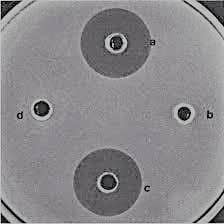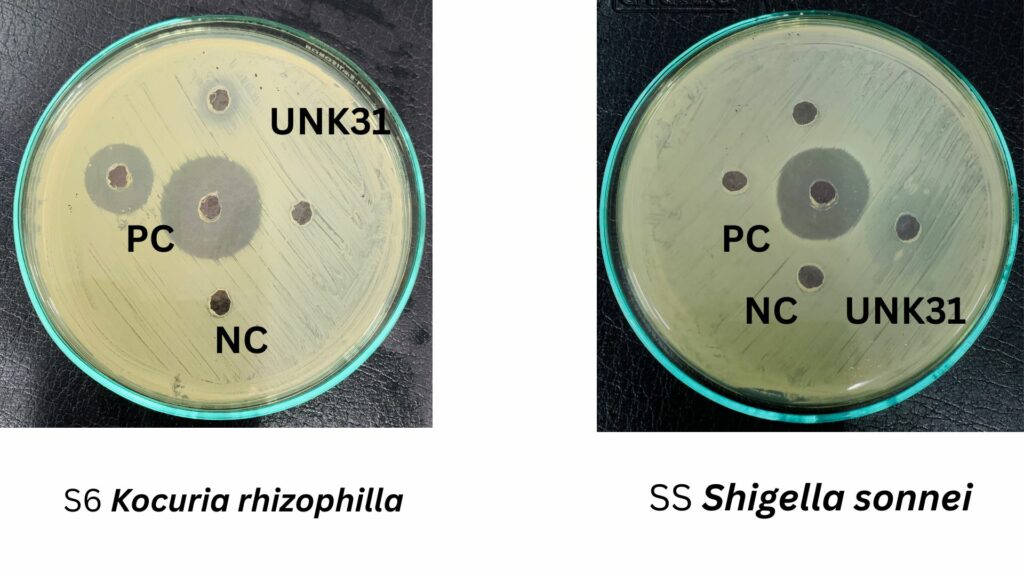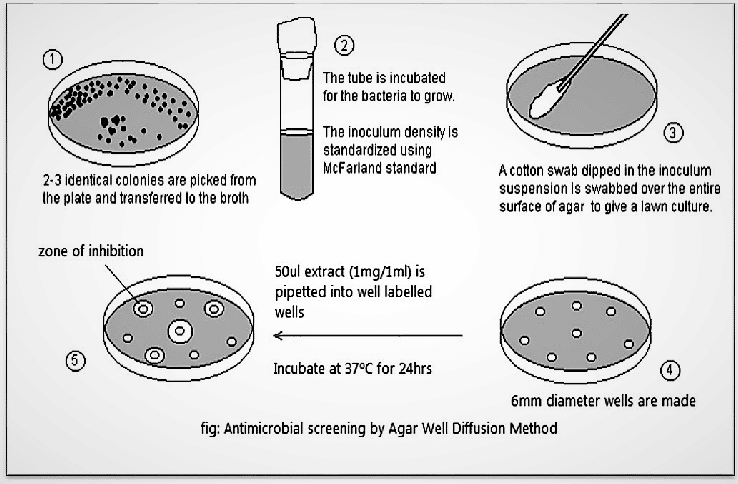Table of Contents
ToggleDefinition of Antimicrobial activity
Antimicrobial activity by Agar well diffusion is a widely used technique for antimicrobial activity. It is the process of inhibiting the growth of microorganisms and decreasing their shelf life and prevent from the formation of microbial colonies. This process can be done by various methods in bacteria. Like agar well diffusion, disc diffusion method, etc.

Antimicrobial activity vs Antimicrobial susceptibility
The word “antimicrobial activity” refers to all active principles (agents) that can inhibit the growth of microorganisms, prevent the formation of microbial colonies, and possibly even destroy them whereas Antibiotic susceptibility tests are used to identify the exact antibiotics that a certain strain of bacteria or fungus is susceptible to. The results of a Gram stain and culture, which are often obtained considerably more quickly, are commonly supplemented by this testing.
Antimicrobial activity of Actinomycetes
Generally, the actinomycetes isolated from the soil are subjected to fermentation and after fermentation, the metabolites are used to show antibacterial activity against other toxic pathogens by using different media. All isolated actinomycetes exhibited antibacterial activity against S. aureus but less so against S. dysenteriae. These isolates have antibacterial properties and might be exploited to create novel antibiotics for use in medicine or agriculture.

Antimicrobial test
To quantitatively determine the minimum concentration (in mg/ml) of an antimicrobial agent required to inhibit or kill the bacteria, dilution testing is utilized. This is accomplished by adding directly to an agar pour, a broth tube, or a micro-broth panel two-fold dilutions of the antimicrobial agent.
Antimicrobial test by Agar well diffusion
Agar well diffusion procedures
Agar well diffusion is used for antimicrobial tests for plant extracts, and secondary metabolites, to check the inhibiting ability of extract against bacteria. Following are the procedures of the agar well diffusion method. In order to evaluate the antimicrobial activity of plant or microbial extracts, the agar well diffusion method is frequently used. The agar plate surface is inoculated using a process similar to the disk-diffusion approach in which a volume of the microbial inoculum is spread across the entire agar surface.
- First of all, we have to prepare the media, that is muller Hinton agar and muller Hinton broth.
- Then the agar is poured into the plates to grow the tested bacteria or organisms.
- The broth is required for growing the tested bacteria.
- When the media are prepared, a loop of tested bacteria like E.coli, and S. aureus were taken and added in 2-3 mL of MHB and incubated at 37 degrees Celsius.
- Now, After 24 hr the bacteria were taken out and the turbidity of the bacteria was matched with Mc Farland ( barium chloride + sulfuric acid) to maintain the approx amount of bacteria in each plate.
- After matching the turbidity, by the process of a cotton bud, the bacteria were swapped on MHA plates with continuous rotation at a 60-degree angle.
- Then after drying, the well was made in the plates with borer and positive, and negative control, and extracts were added to that well.
- Neomycin was used as positive control depending upon the protocol, DMSO as the negative control, and the extract was added.
- Finally, it was incubated for 24 hrs at 37-degree celsius and was observed.
- After 24 hrs, the zone of inhibition was measured. That is the measurement of inhibiting the growth of bacteria by the extracts.

What are positive control and negative control?
Negative controls are specific samples that are included in the experiment and are given the same treatment as the others but are not thought to be affected by any of the experiment’s variables.
The positive control sample will display the anticipated outcome, assisting the scientist in determining whether the experiment was carried out correctly.
Factor affecting the antimicrobial activity
Numerous parameters, including bacterial condition (susceptibility and resistance, tolerance, persistence, and biofilm), inoculum size, antimicrobial concentrations (including the MSW and sub-inhibitory concentration), and host characteristics, affect the effectiveness of antibiotics.
Effect of temperature on antimicrobial activity
When the ambient temperature is raised and antimicrobial drugs are used at high concentrations, their antibacterial activity is significantly but variably improved. When the incubation temperature was lower than usual and/or when the nutrition level was lower, the zones of inhibition were greater; when the temperature was raised and/or when the nutrient content was increased, the zones were smaller.
MCQs/FAQs
Why are positive control are needed in experiments?
A positive control group is used to account for uncontrollable factors that may have affected an experiment and to help scientists identify issues with their findings.
What is the difference between agar well diffusion and disc diffusion method?
The agar, well diffusion process includes making a hole or well on the medium, and adding the extract solution to the well to measure the antimicrobial activity. In contrast, the extract solution is put into a filter paper disc and then deposited on the agar surface in the agar disc diffusion method.
How do you determine antimicrobial activity?
By measuring the zone of inhibition, which included the wells’ diameter, following the incubation period, antimicrobial activity was identified. As a negative control, a 10% DMSO concentration was used.
What are the advantages of agar well diffusion?
The advantage of the agar well diffusion assay is that you can usually load more samples at one time into a well, compared to loading a disc. Diffusion of the Phyto compound through the agar is an important factor when using the agar well diffusion method






